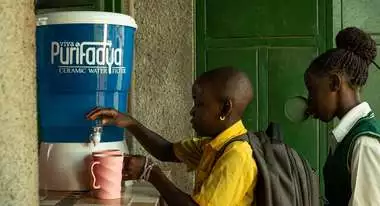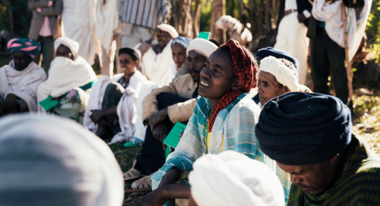"Often it is impossibe to help people in a situation of unpredictable violence and looting."
The Sudanese people are caught in the crossfire between government troops and paramilitary forces. How can humanitarian aid reach displaced people threatened by hunger? WHH General Secretary Matthias Mogge was on the ground.

One year ago, on April 15, fighting between the paramilitary Rapid Support Forces (RSF) and the Sudanese Armed Forces (SAF) started in several places throughout the country. Since then, the conflict has caused widespread displacement of civilians. According to the International Organization of Migration’s (IOM) Displacement Tracking Matrix (DTM) more than 6,5 million individuals have been internally displaced. More than 420.000 of these are hosted in the state of Gedaref, 240.000 in Red Sea State and 190.000 in Kassala. Matthias Mogge, Secretary General of INGO Welthungerhilfe (WHH), visited some sheltering communities near Port Sudan, in the east Sudanese Red Sea State.
Mr. Mogge, your visit led you to Port Sudan, on the far eastern coast of this huge central African country. Why there?
The government of Sudan, some donors and many NGOs have moved their offices from the capital Khartoum, where fighting persists in the greater region, to Port Sudan in Red Sea State. This major port is located around 680 Kilometers northeast of Khartoum. Humanitarian assistance and longer-term programs are coordinated from there. Besides North Darfur, Welthungerhilfe is working in the eastern states of Red Sea, Kassala and Gedaref, where conditions are relatively calm and stable. But of course, the effects of the war are also felt there. Hundreds of thousands of people have fled local conflicts to find refuge in these areas. Daily life in general in Sudan has become very difficult: banks are not fully functioning, the cost of food and fuel has increased, medical supplies are scarce, in fact, the entire economy has largely collapsed.
What are the immediate needs in Port Sudan?
In eastern Sudan the security situation remains relatively stable. Nevertheless, local structures are experiencing enormous strain. IDPs are distributed to host communities and to rented accommodation. Thousands live in improvised or other critical shelters such as schools or other public buildings, as well as open-area informal settlements. WHH is working with local authorities and aid agencies to provide assistance such as emergency shelter, water and sanitation for displaced people. Because of the fighting in Khartoum, Darfur and several other areas, local markets were closed, blocking access to food and water for broad segments of the population. Many of the people who sought refuge here have fled neighborhoods in and around the capital. At the beginning, we provided household essentials, including furniture, matrasses, cooking utensils, pots and crockery.
And the situation now?
I mainly visited the IDP center Alshahinat on the outskirts of the city, as well as two partner organizations – Sahari and Abuhadia – in the wider vicinity. The Alshahinat Gathering Centre, once a school dormitory, has a capacity to house more than 1,000 people. Each family of 8 to 12 people is assigned a room. WHH is transporting 20,000 litres of water daily to the Centre, a crucial lifeline for its residents, and which equates to approximately 20 liters of water per person per day. This is made possible by the Sudan Humanitarian Fund (SHF), a multi-donor Country-Based Pooled Fund managed by OCHA. With their support WHH is also organizing transport to remove human waste, for example from the Al-Hegra neighborhood center. It is very important to prevent spreading of diseases in crowded places like this – in fact, thousands of cases of cholera have already been reported across Sudan and more than 300 people have died as a result.
What is the reaction of local people to the massive influx of IDPs?
What is really impressive is the remarkable solidarity of people in Port Sudan for their fellow Sudanese coming from other areas. They took the first initiative to host them, they brought food and water, and afterwards organizations like WHH came here and helped with water supply tanks and sanitation measures for hygiene. People are not helpless.IDP centres are often managed by neighborhood committees. IDPs are hosted in youth centers or assembly halls. Other INGOs added support such as recreational and protection measures for children and women.
There is a functioning solidarity among the Sudanese when circumstances allow. But in bigger IDP centers like Alshahinat the immediate neighborhood is overwhelmed by the number of displaced people staying there. UN organizations and NGOs are providing assistance to ensure the essential needs of people are met. Still, current assistance is not enough, and needs are growing every day.
How is the work of WHH affected?
The conflict has forced many staff members to flee their homes. Despite the relocation of some staff members and the Country Office from the capital Khartoum to Port Sudan, NGOs are still working almost throughout the country. The fighting has sometimes disrupted humanitarian aid programs, staff was evacuated and brought back again later. Consequently, the threats of hunger, malnutrition, and disease increase. Longer term assistance is sometimes continued, sometimes stopped or changed into relief operations. The volatile context demands high flexibility in terms of location as well as programming and tools applied. Our aim is always to be with the communities, to accompany our partners and involve sector authorities if the security situation allows.
It sounds like a challenging environment...
The conflict in Sudan is one of the most deadly and harmful for the civilian population and the fastest unfolding crisis globally. Approximately 5 million people are at an emergency level of hunger (IPC 4). Humanitarian aid workers face increasing difficulties to assist those in dire need. Of the 5 million only around 2 million can be reached by UN organizations or international and national NGOs.
Severe fighting in many parts of the country between troops of the Rapid Support Forces (RSF) and the army of the Sudanese government (SAF) makes it almost impossible to establish reliable support. Time consuming procedures and endless approval processes for humanitarian movements inside the country make relief operations costly, lengthy and unnecessarily laborious. Assisting people in such an environment of unpredictable outbreaks of severe fighting, looting of offices and warehouses with relief items is often impossible. Humanitarian aid workers are risking their lives to assist those in need.
What are your demands?
The parties to the conflict should at least ensure that humanitarian corridors are kept open so that humanitarian groups can safely provide assistance, so that aid can be transported to those in need. Even better would be a cessation of hostilities, even a temporary one, so that civilians can safely leave the areas of conflict. And they should refrain from attacking infrastructure such as water, telecommunications and electricity as well as local markets, which are essential for the population.
Is there any prospect of an end to this conflict?
This conflict is a showcase for the violation of International Humanitarian Law. Currently, there is no peace in sight. Both parties still believe firmly they can win the battle, so civilians continue to suffer, continue to be displaced from their homes in many parts of Sudan. The interference of various foreign states in the conflict makes a resolution extremely complicated and difficult. All this comes after a period of great hope for a democratic Sudan when long term dictator Omar Al Bashir was removed in 2019 by popular protests and the military.
Today people are deeply frustrated and desperate. The war has led to the closure of all schools and universities. Many schools now serve as centers for internally displaced people and can no longer be used for educational purpose. Even in more peaceful provinces schools are not open and students stay at home. Only some private schools are still running.
What can donors do?
We should not forget that the situation in Sudan was already critical even before this conflict broke out. Early in 2023, almost 16 million Sudanese, 30 percent of the population, needed assistance to avoid hunger and malnutrition – and at the time, only 49 percent of the required funding was provided. This year’s planting season has already started with inadequate funds. There is a real danger that the underlying food crisis will continue to spiral out of control.
The ongoing humanitarian needs demand continued support by donors and private supporters. The conflict in Sudan has destabilizing effects outside the country with hundreds of thousands of refugees fleeing the country towards Egypt, Chad, South Sudan, Ethiopia and the Central African Republic. These are countries which face internal tensions themselves. The official count is 1,8 million people who fled to neighboring countries – besides the 6,5 million internally displaced Sudanese. Up to 25 million people, of which 14 million are children, are in need of humanitarian assistance. It is of utmost importance to continue humanitarian relief efforts to mitigate the suffering, avoid more deaths of children and innocent citizens.
Mathias Mogge spoke to Marina Zapf and Hans Brandt






